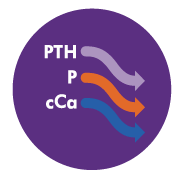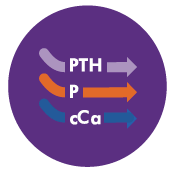

I’LL DO ALL I CAN
TO PRESCRIBE
WHAT I BELIEVE
IS
RIGHT FOR MY
PATIENT.
There’s more than one reason
why Parsabiv® is prescribed
by nephrologists for their clinically appropriate patients.


I WILL ADVOCATE
FOR THE
TREATMENT I
BELIEVE IS RIGHT
FOR MY PATIENT.
There’s more than one reason why Parsabiv® is used by dialysis care teams for their clinically appropriate patients.


WHEN A
TREATMENT’S
RIGHT FOR MY
PATIENT, I'LL
STAND BEHIND IT.
There’s more than one reason
why Parsabiv® is prescribed by nephrologists for their clinically appropriate patients.


I WILL WORK HARD
FOR A TREATMENT
WHEN I BELIEVE
IT’S RIGHT FOR MY
PATIENT.
There’s more than one reason
why Parsabiv® is used by dialysis care teams for their clinically appropriate patients.


WHEN A
TREATMENT IS
RIGHT FOR MY
PATIENT, IT'S
WHAT
I PRESCRIBE.
There’s more than one reason why Parsabiv® is prescribed by nephrologists for their clinically appropriate patients.
Parsabiv®® gives you control over calcimimetic delivery at the end of hemodialysis1

CONTROL
delivery with IV administration1
LOWER
3 key secondary HPT lab values1,*
MAINTAIN
lab reductions up to 78 weeks1,†*Results are combined from two 26-week, randomized, double-blind, placebo-controlled studies comparing Parsabiv® (etelcalcetide) with placebo in patients with chronic kidney disease (CKD) on hemodialysis.
† Open-label extension (OLE): data pooled for patients receiving Parsabiv® across two placebo-controlled parent studies and a subsequent OLE study, starting from the baseline of the parent study until the end or the prespecified cutoff date of the OLE study, whichever was earlier.2
Parsabiv® is the first and only IV calcimimetic1
While Parsabiv® (etelcalcetide) and oral cinacalcet are both calcimimetics, these are two distinctly different drugs. See the mechanism of action for Parsabiv® and oral cinacalcet below
Parsabiv®
- Binds directly to the extracellular domain of the CaSR1,3
- Synthetic peptide3
- Steady state reached in 7-8 weeks1
Oral cinacalcet
- Binds to the transmembrane domain of the CaSR3,6,7
- Small molecule compound7
- Steady state reached within 7 days6
EFFICACY
See how Parsabiv® performed
in clinical trials and its use in real-world outcomes
REAL-WORLD EVIDENCE
See an analysis from
hundreds of real-world treatment experiences
CARE TEAM CORNER
Parsabiv® videos and information specifically for dietitians, nurses, and technicians





